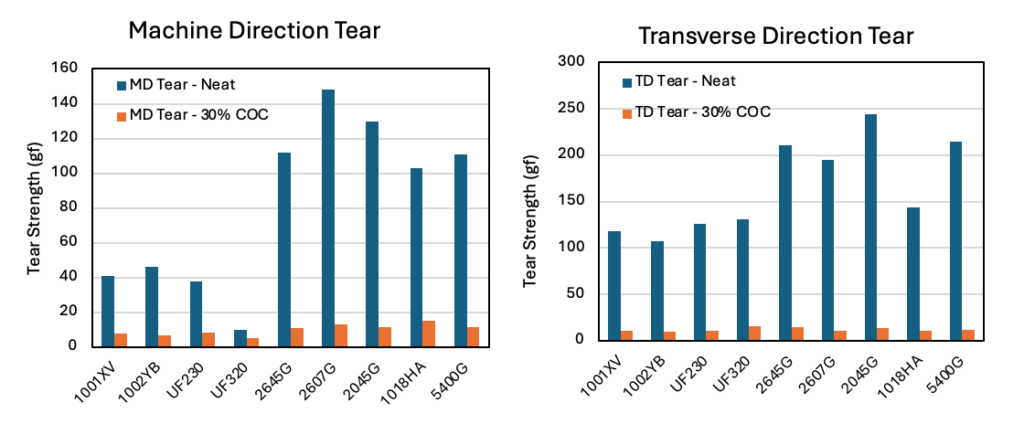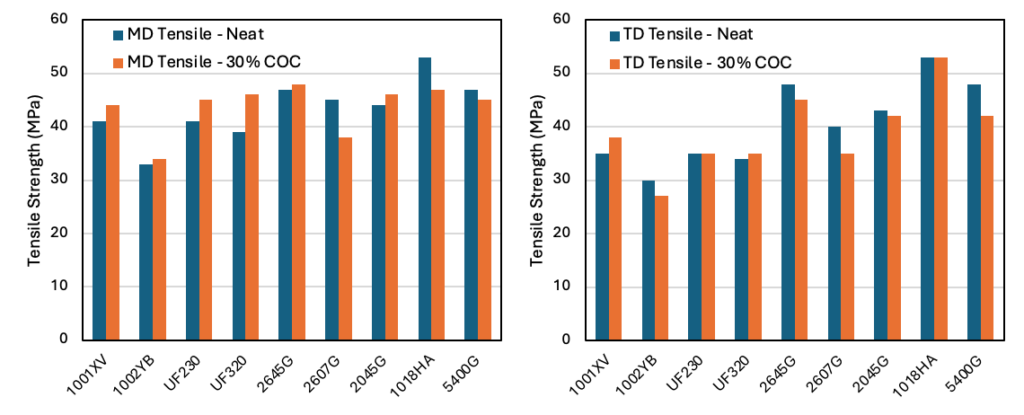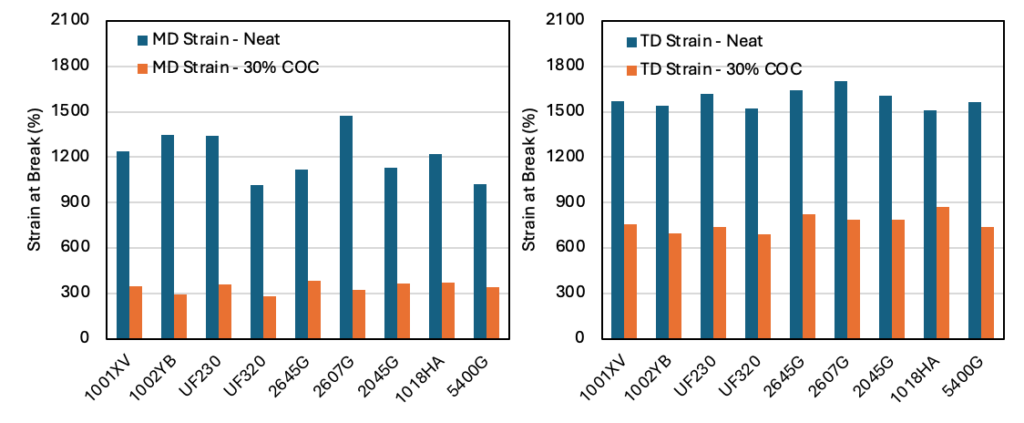Easy Tear Properties of LLDPE with TOPAS® COC 8007F-500
Introduction
As the flexible packaging industry moves towards mono-material solutions, one challenge to overcome is maintaining easy open features like directional tear. This is particularly true when using linear low density polyethylene (LLDPE), a family of alpha-olefin copolymer polyethylenes known for their toughness. One way to generate easy tear in LLDPE films is to introduce TOPAS® COC into the film. The rigid ethylene-norbornene copolymer (COC) results in substantially easier tear in both directions compared to the control while maintaining the tensile strength at break that LLDPE is known for.
Materials
A selection of nine LLDPE resins and one COC resin were chosen for this evaluation.
| Grade | Manufacturer | Comonomer & Catalyst | Density (g/cc) | Melt Index |
| 1001XV | ExxonMobil | Butene-LLDPE, Ziegler-Natta | 0.918 | 1.0 |
| 1002YB | ExxonMobil | Butene-LLDPE, Ziegler-Natta | 0.918 | 2.0 |
| UF230 | Japan Polyethylene Corp. | Butene-LLDPE, Ziegler-Natta | 0.921 | 0.9 |
| UF320 | Japan Polyethylene Corp. | Butene-LLDPE, Ziegler-Natta | 0.922 | 1.0 |
| 2645G | Dow Chemical | Hexene-LLDPE, Ziegler-Natta | 0.919 | 0.9 |
| 2607G | Dow Chemical | Hexene-LLDPE, Ziegler-Natta | 0.918 | 2.3 |
| 2045G | Dow Chemical | Octene-LLDPE, Ziegler-Natta | 0.920 | 1.0 |
| 1018HA | ExxonMobil | Hexene-LLDPE, Metallocene | 0.918 | 1.0 |
| 5400G | Dow Chemical | Octene-LLDPE, Metallocene | 0.916 | 1.0 |
| 8007F-500* | Polyplastics | Ethylene-Norborne, Metallocene | 1.010 | 1.8 |
* Note that TOPAS® COC 8007F-500 is obsolete and has been replaced by 8007F-600. For the purpose of this study, the performance of the two grades should be considered identical.
Formulation and Processing
Each LLDPE resin was run on its own as a neat resin and with a 30% blend of 8007F-500 added in.
Films were run as mono-layer blown films. The extruder temperature was set to 210°C. The die temperature was 190°C. The blow-up ratio was 2.0. And the collected film thickness was 50µm. For films with blended COC, the LLDPE and COC were introduced as a pellet blend, not as a pre-compounded blend.
Results
The Elmendorf tear strength of the neat LLDPE resin films varies depending on the kind of comonomer in the polymer. The butene copolymers [1001XV, 1002YB, UF230, and UF320] all have significantly lower tear strength than the hexene and octene copolymer LLDPE films. A potential exception is that 1018HA had a transverse direction tear strength only slightly higher than the butene LLDPE’s. And one grade, UF320, had a machine direction tear strength about 25% of that of the other butene LLDPE resin films.
Adding 8007F-500 to these films reduces the tear strength even further. The reduction in tear resistance is most dramatic when evaluating the transverse direction tear property. The COC inclusion films have an average tear strength of 8% of that of their non-COC containing control films. The machine direction and transverse direction tear results can be found in Figure 1, below.

Figure 1: Machine direction and Transverse direction tear properties for the eight LLDPE resins neat and with a 30% blend of TOPAS® COC 8007F-500.
The addition of 30% 8007F-500 to the LLDPE films did not have a strong impact on the films’ ultimate tensile strength. This was true in both the machine direction and transverse direction. The tensile strength at break results can be found below in Figure 2.

Figure 2: Machine direction and Transverse direction Tensile Strength at Break for the eight LLDPE resins neat and with a 30% blend of TOPAS® COC 8007F-500.
While the 30% COC addition did not impact the tensile strength, it did dramatically impact the strain at break in the films. COC resins have very low strain at break at room temperature because the resins are in a glassy state. Given this, it is not surprising that blending COC into LLDPE films resulted in reduced strain at break. The reduction in strain at break was approximately two-thirds for the machine direction and about half for the transverse direction. The strain at break data can be found in Figure 3, below.

Figure 3: Machine direction and Transverse direction Strain at Break for the eight LLDPE resins neat and with a 30% blend of TOPAS® COC 8007F-500.
Analysis
The addition of 30% COC into a mono-layer film of LLDPE resulted in greatly enhanced easy tear, generated minimal impact to tensile strength, and created large reductions in strain at break. The tensile strength at break property for a LLDPE is typically the result of the strain hardening of the LLDPE chains at higher strain levels. That the films with 30% COC did not achieve as high of strain as the non-COC films, thus did not have as much strain hardening potential, but still achieved the same tensile strength at break should be noted. So, while the elongation at break was reduced, the tensile performance of the film was not compromised by adding 30% COC to the film.
An alternative approach to the one taken in this study would be a discrete layer, or multiple discrete layers, of COC in a coextruded film with LLDPE. By using discrete layers of COC in a coextrusion the resulting film will see more of the typical COC properties transferred to the LLDPE and COC blended film. Specifically, the coextruded film would have greatly increased tensile modulus at room temperature and at elevated temperatures, depending on the grade of COC selected. The coextruded version would also see easy tear properties as well as reduced strain at break.
Conclusion
The data in the study demonstrates that adding COC to a film with a variety of LLDPE resin architectures can improve the easy tear characteristics of LLDPE, without sacrificing the ultimate tensile strength of the film. As the flexible packaging market steadily moves towards mono-material solutions, the addition of TOPAS® COC may be the right fit for easy open packaging in food, medical, and industrial packaging.
Material Note
This study reports using TOPAS® COC 8007F-500, an older version of 8007F-600 that is no longer available on the market. For the data reported here, the two grades should be considered identical.
For more information on TOPAS® plastics, see our product info, or contact us.
